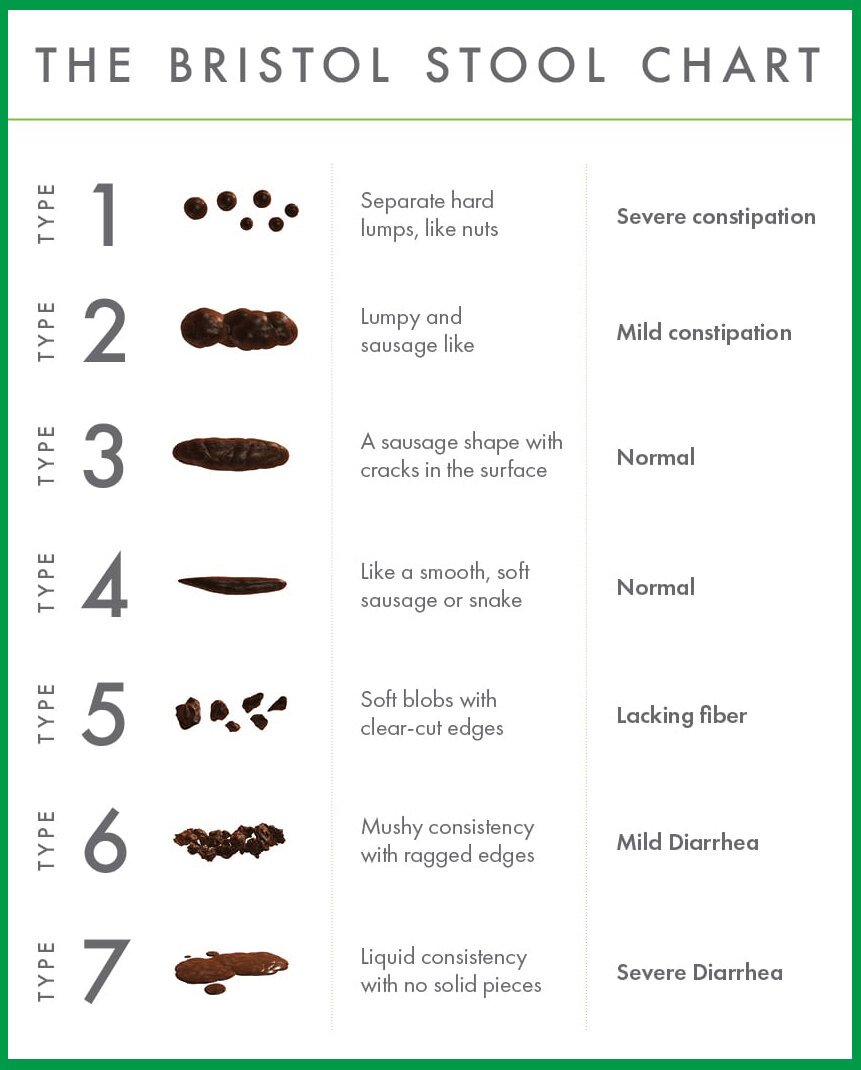What Does Your Poop (and your kid's poop) Say About Your Digestion?
There is a lot to be learned from our poop! The type of poop you (hopefully) have each day is a direct indication of the health of your digestion. The Bristol Stool Chart is an excellent guide to interpret your digestive health based on what your stools look like.
On the Bristol Stool Chart there are 7 types of stools:
Type 1 - separate hard lumps - severe constipation
Type 2 - lumpy and sausage like - mild constipation
Type 3 - a sausage shape with cracks in the surface - normal
Type 4 - like a smooth, soft sausage or snake - normal
Type 5 - soft blobs with clear-cut edges - lacking fiber
Type 6 - mushy consistency with ragged edges - mild diarrhea
Type 7 - liquid consistency with no solid pieces - severe diarrhea
Beyond those 7 stool types, here are some other questions to consider with your stools:
Do you experience chronic diarrhea?
Do you experience diarrhea shortly after meals?
Are your stools black or tarry colored?
Do you notice undigested food in your stools?
Are your stools greasy or shiny?
Are your stools light or clay colored?
Do your stools float or sink?
Do you experience less than 1 bowel movement per day?
Do you experience irritable bowel?
Do you have blood or mucus in our stools?
Experiencing any of these symptoms is a sign there is some dysfunction going on in the digestive system.
The digestive process works north-to-south in your body. It begins in the brain when the sight and smell of food triggers the salivary glands to begin producing saliva. The mouth then completes the physical and mechanical breakdown of food by chewing food with the teeth and using saliva to soften and swallow the food. After you swallow, the food now called the bolus, moves through the esophagus into the stomach. When in the stomach, gastric juices (HCl, pepsinogen/pepsin, and mucous) are secreted to further break down the bolus into a very acidic paste called chyme. The chyme paste then enters the small intestine. In the small intestine mucous and hormones are stimulated to release bile and pancreatic juice. Bile is necessary to further breakdown and assimilate dietary fat, and pancreatic juices help to neutralize the acidity in the chyme. By the time the chyme is ready to move into the large intestine it is almost completely digested-- carbs are broken down into glucose, proteins are broken down into amino acids and pepsin, and fats are broken down into fatty acids and glycerol. The remaining chyme that enters the large intestine consists of indigestible fiber, bile, water, and discarded cells. In the large intestine water is recycled and any remaining usable nutrients are absorbed before the remaining waste is formed into poop and excreted.
There are many moving parts in the digestive process and dysfunction at any level can contribute to the type of bowel movement you experience along with any symptoms. Because we are all bio-individual it can be inaccurate to say any one symptom contributes to your type of bowel movement. It is rather a combination of symptoms in addition to food and lifestyle choices. If you are ready to do the work and uncover what’s contributing to your bristol number and symptoms, please book a clarity call with me!
In the meantime, here are some simple ways you can support your digestion:
Chew your food very thoroughly. 20-30 chews per bite of food. It helps to put your fork down in between bites.
Avoid drinking liquids at meal times. Liquids can dilute your gastric juices, which will contribute to the improper breakdown of food. Small sips if necessary!
Drink a glass of warm lemon water 30 minutes prior to a meal. This can help to stimulate and soothe the digestive tract prior to introducing food.
Eat in a relaxing environment. Eat meals sitting down, away from screens and other distractions. This will support your body’s parasympathetic “rest and digest” state.
If necessary, incorporate a digestive supplement. See my blog post HERE on stomach acid and how it helps with digestion.


